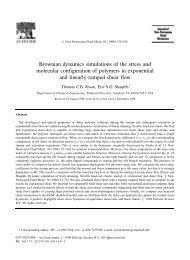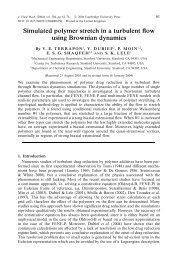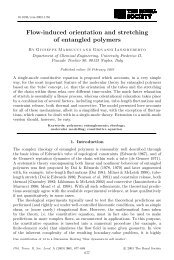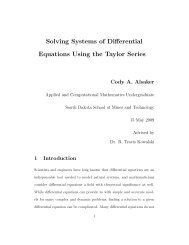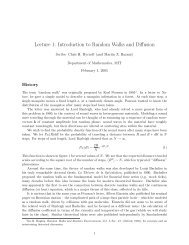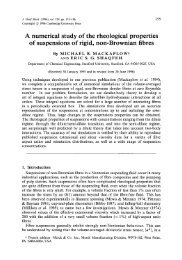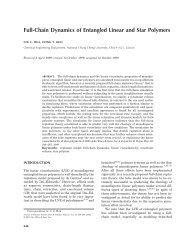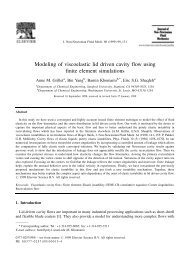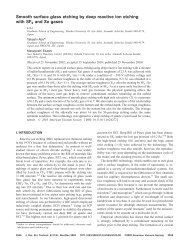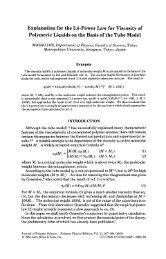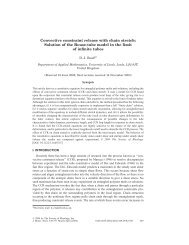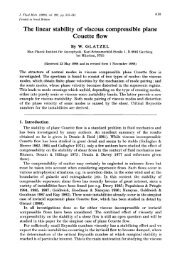Molecular modelling of entangled polymer fluids under flow The ...
Molecular modelling of entangled polymer fluids under flow The ...
Molecular modelling of entangled polymer fluids under flow The ...
You also want an ePaper? Increase the reach of your titles
YUMPU automatically turns print PDFs into web optimized ePapers that Google loves.
2.5. BRANCHED POLYMERS 41<br />
density polyethylene (LDPE) using the multimode approach described by Inkson et al.<br />
(1999). Commercial LDPE is a polydisperse blend <strong>of</strong> molecules with multiple irregularly<br />
spaced long chain branches. Each section <strong>of</strong> this complex molecular architecture<br />
has its own time-scales for orientation and stretch relaxation. Under the multimode<br />
method these sections are modelled by a superposition <strong>of</strong> pom-pom molecules <strong>of</strong> differing<br />
relaxation times and arm numbers. <strong>The</strong> stress contribution <strong>of</strong> these pom-pom<br />
molecules is then summed to obtain the total stress,<br />
σ<br />
≈<br />
=<br />
n∑ n∑<br />
σ = 3 g i λ 2<br />
≈<br />
i S (2.43)<br />
i ≈ i.<br />
i=1 i=1<br />
<strong>The</strong> approximation is the decoupling <strong>of</strong> the modes <strong>of</strong> a connected molecule. <strong>The</strong>re<br />
ought to be interactions between the separate sections on the same molecule, however<br />
these are neglected. <strong>The</strong> moduli, g i , and backbone orientation times, τ bi for a particular<br />
melt can be determined from the linear viscoelastic behaviour <strong>of</strong> the material.<br />
However, the values <strong>of</strong> τ s and q must be determined from a non-linear <strong>flow</strong> experiment,<br />
usually uniaxial extension. In the multimode formulation <strong>of</strong> the pom-pom model<br />
the direct computation <strong>of</strong> timescales from molecular structure is replaced by fitting to<br />
experimental rheology. This set <strong>of</strong> variables {τ bi , g i , τ si , q i } can then by used to make<br />
successful predictions for other simple <strong>flow</strong>s, such as shear and planar extension, and for<br />
complex geometries [Lee et al. (2001)]. <strong>The</strong> method is a generalisation <strong>of</strong> the practice<br />
<strong>of</strong> fitting a spectrum <strong>of</strong> Maxwell modes to linear oscillatory shear data. In this case the<br />
spectrum is extended to include non-linear parameters and the pom-pom model is used<br />
as the <strong>under</strong>lying theory. It should be noted that the range <strong>of</strong> phenomena captured by<br />
this approach is significantly larger than that <strong>of</strong> linear response.<br />
2.5.4 Discussion <strong>of</strong> multimode pom-pom model<br />
On first inspection the decoupling <strong>of</strong> different sections <strong>of</strong> a connected molecule appears<br />
to be severe approximation. It is then, perhaps, surprising that the method works<br />
so well. Blackwell et al. (2001) have investigated this decoupling by deriving a more<br />
rigorous tube theory for symmetric molecules containing multiple layers <strong>of</strong> branching<br />
including the appropriate coupling through the branch points. <strong>The</strong>y compared their<br />
predictions to those <strong>of</strong> the multimode pom-pom and managed to identify some discrepancies<br />
which also appear in the comparison <strong>of</strong> the pom-pom model with real data.<br />
Generally, the errors were not serious, though. It is likely that the errors associated<br />
with the decoupling occur a large strains, particularly in steady state. In this case the<br />
errors will be screened out by the viscous contribution from modes which are in linear<br />
response. This mechanism also explains why the multi-mode pom-pom can be used to<br />
model non-linear shear <strong>of</strong> branched <strong>polymer</strong> melts despite the omission <strong>of</strong> CCR (see



